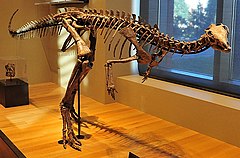| Dryosaurus Temporal range: Late Jurassic,
| |
|---|---|

| |
| D. altus, Beneski Museum of Natural History | |
| Scientific classification | |
| Domain: | Eukaryota |
| Kingdom: | Animalia |
| Phylum: | Chordata |
| Clade: | Dinosauria |
| Clade: | †Ornithischia |
| Clade: | †Neornithischia |
| Clade: | †Ornithopoda |
| Family: | †Dryosauridae |
| Genus: | †Dryosaurus Marsh, 1894 |
| Type species | |
| †Dryosaurus altus (Marsh, 1878) [originally Laosaurus altus]
| |
| Other species | |
Dryosaurus (/ˌdraɪəˈsɔːrəs/ DRY-ə-SOR-əs, meaning 'tree lizard', Greek δρῦς (drys) meaning 'tree, oak' and σαυρος (sauros) meaning 'lizard'; the name reflects the forested habitat, not a vague oak-leaf shape of its cheek teeth as is sometimes assumed) is a genus of an ornithopod dinosaur that lived in the Late Jurassic period. It was an iguanodont (formerly classified as a hypsilophodont). Fossils have been found in the western United States and were first discovered in the late 19th century. Valdosaurus canaliculatus and Dysalotosaurus lettowvorbecki were both formerly considered to represent species of Dryosaurus.[1][2][3]
- ^ Tom R. Hübner; Oliver W. M. Rauhut (2010). "A juvenile skull of Dysalotosaurus lettowvorbecki (Ornithischia: Iguanodontia), and implications for cranial ontogeny, phylogeny, and taxonomy in ornithopod dinosaurs". Zoological Journal of the Linnean Society. 160 (2): 366–396. doi:10.1111/j.1096-3642.2010.00620.x.
- ^ McDonald AT, Kirkland JI, DeBlieux DD, Madsen SK, Cavin J, et al. (2010). Farke AA (ed.). "New Basal Iguanodonts from the Cedar Mountain Formation of Utah and the Evolution of Thumb-Spiked Dinosaurs". PLOS ONE. 5 (11): e14075. Bibcode:2010PLoSO...514075M. doi:10.1371/journal.pone.0014075. PMC 2989904. PMID 21124919.
- ^ Galton, P.M., 1977. "The Upper Jurassic dinosaur Dryosaurus and a Laurasia-Gondwana connection in the Upper Jurassic", Nature 268(5617): 230-232